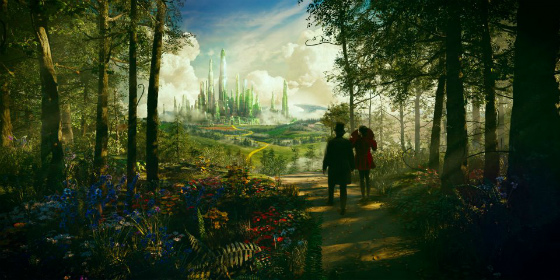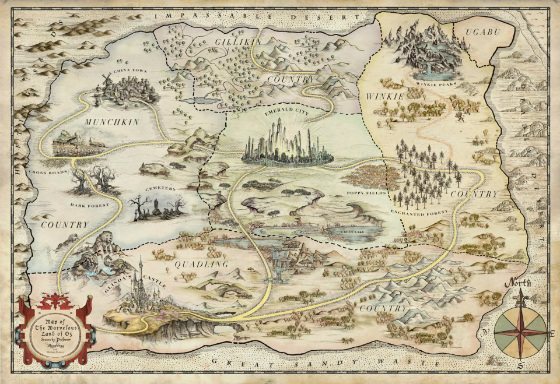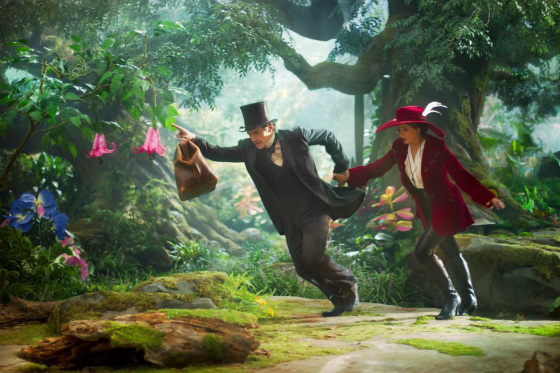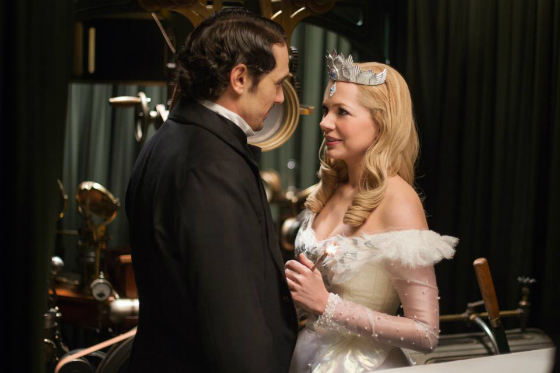Fanboy Flick Pick: Sam Raimi’s Oz is Powerful but Not so Great
 |
(Note: all images are from the movie’s official Facebook page)
To partially appropriate that famous quotation Winston Churchill probably didn’t say: if you’re not smiling during the opening moments of Sam Raimi’s Oz the Great and Powerful, you’ve got no soul. If you’re still smiling by the time the movie’s over, you’ve got no discernment.
It shouldn’t be that hard to do Oz right onscreen – just hit the books and adapt L. Frank Baum’s words as he wrote them. They’ve been pleasing children forever, and they certainly pleased me a great deal in my own youth. The problem with adapting them cinematically is that you can’t simply buy all the rights at once and hold them exclusively – all of the Baum books being in the public domain – so that, for example, if Disney were to announce tomorrow that they’re making Ozma of Oz, Universal could turn around the next day and put The Patchwork Girl of Oz into development. That’s why you see so many studios, comic-book companies and such more interested in putting their own spin on the story: it gives them elements they can trademark as their own.
 |
| Yeah, nice try, but no. |
Raimi has been claiming up and down that his new movie is based on the books rather than the MGM movie version of The Wizard of Oz, which is transparent bullshit to anybody who knows what they’re talking about, and most likely a verbal dodge he has to make to avoid liability and lawsuits. The look of the Wicked Witch of the West, the Winkies being evil guards with unique outfits rather than farmers dressed in yellow, the Munchkins being little people – these are all MGM creations not found in the book, as is the amalgamation of Glinda and the Good Witch of the North into one character. From Baum we do get the China Country (here punnily called China Town) and the Quadlings, but they’re not the Quadlings of the books. Even the lions hidden in the scenery and architecture feel more like tributes to the MGM mascot than Oz’s most notable coward
Most significantly, Raimi borrows the more famous movie’s biggest innovation – the use of black and white footage for Kansas, and actors double-cast in real world and Oz roles, which makes less sense in a film that never presents itself as a possible dream. It does, however, offer one terrific throwaway, when Michelle Williams, in the role of the Wizard’s Kansas lover, tells him she’s going to marry John Gale. Williams, as you know, also plays Glinda…and Dorothy’s surname is Gale. Note: if that happens to bother you, trust me, it gets more incestuous: this wizard, whose actual name is Oz (short for Oscar Zoroaster), is quite the ladies’ man, and the witches are less chaste than you may remember (or than Baum, who avoided romance in the tales because he thought children would hate it, might have liked).
Anyway, be sure not to come in late to the movie, because you’ll miss the best part. Using a near 1:1 aspect ratio – a small square in the middle of the screen, which Raimi frequently cheats by having things like fire escape outside the border – things begin with the Disney castle logo on black and white 3D, as our POV actually enters the castle, in which we find ever increasing layers of depth that resemble an infinite version of those old fashioned paper puppet theater playsets. Raimi is nothing if not a showman who likes to use every trick in the book, and he plays with 3D as expertly as he played with my nerves in Drag Me to Hell (and the first Evil Dead way back when). It is inevitable that when a cyclone takes us to the land of Oz, the screen will open up and turn to color, yet the B/W stuff arguably contains the best visuals of the whole thing, especially the slapstick sequence aboard the balloon in which Franco gives his best Bruce Campbell, dodging numerous 3D objects out to kill him.
 |
This is like Raimi’s version of Hugo. Oz (James Franco) begins life as a carnival huckster, yet by the time he’s done, he’s using special effects on a grand scale to inspire and thrill. In that way – no matter what Raimi himself says! – Oz’s journey parallels that of cinema itself, from sideshow gimmick to epic storytelling. But there is a key difference – Georges Melies was a magician, but he was one who ultimately wanted to delight the audience, and Martin Scorsese, using the most modern of cinematic magic tricks, did likewise in his telling of the director’s tale. Oz, on the other hand, is a huckster who uses the medium to fool people, and sad to say, Raimi feels like one here too, dazzling us with effects to distract us from the con man behind the curtain.
I will say I found the departures from the canon less offensive on a second viewing, though I don’t understand why the director, having done his homework on 3D, leaves in several panning shots that move too fast for the brain to register the depth. Minor lapses, but they occur in scenes when the surroundings are meant to be wowing us.
 |
And make no mistake, this is a direct prequel to the ’30s movie. Again there is no Good Witch of the North; there are but three – Evanora (Rachel Weisz), Theodora (Mila Kunis) and Glinda (Michelle Williams). All of them refer to another wicked witch, and there’s no need for me to ruin the “surprise” identity of same, but if you know your Oz in any form, you’ll know that at least one of those three can be ruled out. You’ll also be amazed at how quickly life-changing decisions are made with little-to-no buildup. When Oz the showman first arrives in Oz the land, he encounters the stunning Theodora, who tells him there’s a prophecy that a wizard will come to be the new king. Sensing riches, he plays along, but there’s a catch – as in Dorothy’s tale, he makes it to the Emerald City to be told he must kill the wicked witch in order to get what he desires. And yes, he meets a couple of unlikely companions along the way: a winged monkey named Finley (Zach Braff) and a china girl (Joey King) who appears to be the last survivor of a flying baboon attack. Both are astonishing effects creations – you never question their reality. I didn’t, anyway, and I suspect kids won’t either.
Raimi avoids the four color-coded countries of the books too, though he mixes the primary hues in throughout, as nearly everything we see that isn’t green is either red, yellow, blue or purple. I raised an eyebrow when the Quadlings were introduced and they weren’t wearing red; then, when the Munchkins showed up as singing, dancing little people, I had to take a deep breath. To an Ozophile, the fact that the word “Munchkin” has become synonymous in the language with something little and cute is grating. The Tin Man’s a Munchkin, after all – or at least he was until he accidentally dismembered himself and became a magic cyborg. True to Baum, my ass. Need I also point out that the witch in the book was neither green nor pointy hat wearing? Or that the Margaret Hamilton lookalike here sports some pretty cheesy makeup? Anyone who says Oz fans will be satisfied has never read the books; mark my words. Maybe you’ll say I shouldn’t be so hung up on the books, and maybe I wouldn’t be if they hadn’t made a point of saying this would adhere to them.
Talk of rebooting The Wizard of Oz after this is just silly, because it leads directly into the existing movie pretty exactly. I’d be more than fine with a genuine, nonmusical reboot, especially if it were to lead to all the books being done, but Oz the Great and Powerful has essentially salted the earth on that score, at least as far as building a Disney franchise is concerned.
They could do a hell of a Splash Mountain makeover based on Franco’s arrival in Oz, though.
